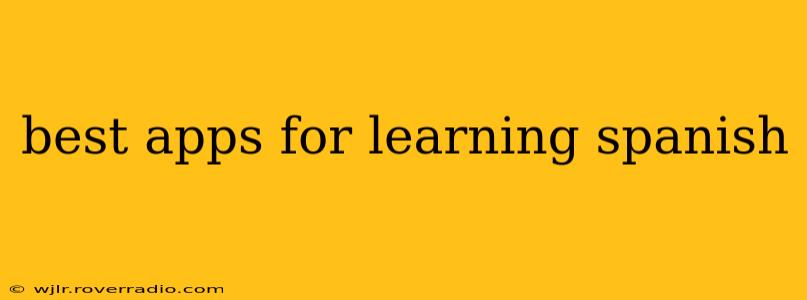Learning a new language can be a rewarding journey, and Spanish, with its rich culture and widespread use, is a particularly popular choice. Fortunately, the digital age offers a plethora of excellent apps to aid your learning. This guide will explore some of the best apps for learning Spanish, catering to different learning styles and budgets. We'll delve into their features, pros, and cons, helping you choose the perfect app to kickstart your Spanish-speaking adventure.
What Makes a Great Spanish Learning App?
Before diving into specific apps, let's define what makes a truly effective tool for learning Spanish. A top-tier app should offer:
- Structured Lessons: A clear progression of learning, from basic grammar and vocabulary to more complex concepts.
- Interactive Exercises: Engaging activities like quizzes, games, and pronunciation practice to reinforce learning.
- Personalized Learning: Adaptive features that adjust to your pace and learning style.
- Native Speaker Audio: Authentic pronunciation to help you develop accurate speech.
- Community Features: Opportunities to interact with other learners or native speakers.
Top Spanish Learning Apps: A Detailed Review
Many excellent apps cater to Spanish learners, each with its unique strengths. Here's a breakdown of some of the most popular and effective:
Duolingo: Fun and Gamified Learning
Pros: Free (with in-app purchases), gamified approach, user-friendly interface, covers basic grammar and vocabulary effectively.
Cons: Can become repetitive, less emphasis on conversational skills in the free version, may not be sufficient for advanced learners.
Duolingo's gamified approach makes learning enjoyable, particularly for beginners. Its points, streaks, and competitive elements motivate users to keep practicing. While it's a great starting point, it might need supplementing with other resources for a more comprehensive learning experience.
Babbel: Focus on Practical Conversation
Pros: Focus on conversational skills, realistic scenarios, personalized learning paths, good for intermediate to advanced learners.
Cons: More expensive than Duolingo, less gamified approach may not appeal to all users.
Babbel prioritizes practical conversation, making it ideal for those aiming to use Spanish in real-life situations. Its structured lessons and interactive exercises are designed to build confidence and fluency.
Memrise: Mnemonics and Memorization Techniques
Pros: Uses mnemonics and flashcards for effective memorization, diverse learning content, incorporates real-world examples.
Cons: Can be overwhelming for beginners, less structured than other apps.
Memrise’s unique approach utilizes mnemonics and user-submitted content, making learning engaging and memorable. While its memorization techniques are excellent, it might require more self-discipline than other structured apps.
Rosetta Stone: Immersive Language Learning
Pros: Immersive learning environment, focuses on developing intuitive language skills, effective for building fluency.
Cons: Expensive, less emphasis on explicit grammar instruction, limited feedback.
Rosetta Stone's immersion-based approach simulates learning a language naturally, mirroring how children learn their first language. While effective, its higher price point and lack of explicit grammar explanations may not suit all learners.
Busuu: Community Interaction and Certification
Pros: Offers opportunities for interaction with native speakers, provides language certification, covers a wide range of vocabulary and grammar.
Cons: Free version has limitations, some users report inconsistent quality of feedback from native speakers.
Busuu distinguishes itself with its community aspect, allowing learners to interact with native speakers for feedback and practice. Its certification option is also a valuable asset for those seeking formal recognition of their language skills.
What are some good Spanish learning apps for beginners?
Both Duolingo and Babbel offer excellent beginner courses. Duolingo's gamified approach can be highly motivating for new learners, while Babbel provides a more structured and practical introduction to the language. Memrise can also be useful for beginners focusing on vocabulary acquisition through its mnemonic techniques.
What is the best app to learn Spanish fast?
There's no single "best" app for rapid learning. Success depends on individual learning styles and consistent effort. However, apps that prioritize active recall, like Memrise, and those with structured lessons and frequent practice, such as Babbel, are generally effective for faster progress. The key is consistent daily practice, regardless of the chosen app.
Which Spanish learning app is best for pronunciation?
Many apps incorporate native speaker audio, but some are better than others. Babbel and Rosetta Stone are known for their high-quality audio and focus on accurate pronunciation. However, consistent practice and attention to detail are crucial regardless of the app used.
Conclusion: Finding Your Perfect Spanish Learning App
The best app for learning Spanish ultimately depends on your individual preferences, learning style, and goals. Experimenting with a few free trials or free versions is a good strategy before committing to a paid subscription. Remember that consistent effort and active engagement are crucial for success, regardless of the app you choose. Combine app learning with other resources like books, podcasts, and immersion activities for an even more effective learning experience.
